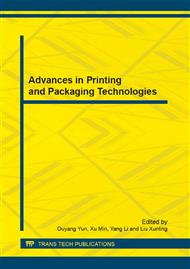p.329
p.334
p.340
p.345
p.349
p.355
p.361
p.367
p.372
Theoretical Research of Color Reproduction on Concentric Dot
Abstract:
Concentric dot is a new shape of ink dot, which subdivides dot of AM screening into ring and space. Concentric dot has morphological characteristics and reproduction characteristics of AM dots and FM dots, also has excellent color reproduction characteristics. Compared with traditional solid dot, high saturation of concentric dot has been proven. However, the mechanism of this phenomenon is rarely reported. Taking AM dots as reference, this paper try to explain the high saturation of concentric dot theoretically from several aspects, and aims to reveal the mechanism of the color reproduction characteristics of concentric dots. Due to the low amount of ink, the surface of concentric dots is smoother, and achieves better reproduction of color. The distribution characteristics of ring and space result in dot gain both inside and outside of concentric dots, which have a positive impact on the color reproduction. Establishing the relationship of optical dot area and saturation, the difference of color reproduction characteristics between concentric dots and AM dots can be analyzed as the result of the different microstructure of two dots. Using the improved Clapper-Yule model and the law of Lambert-Beer, the conclusion above can be analyzed theoretically. On this basis, experiments are designed and carried out to prove the correctness of theoretical analysis. According to the research, several conclusions are made. The conclusions can be list as follow: different saturations of concentric dots and AM dots lead to different color reproduction, when optical dot area stays the same; different saturations of concentric dots and AM dots is mainly caused by the microstructures of the tow dots; Under the same condition of incident light, concentric dots of monochrome ink reflect more of the visible spectrum than AM dots after absorption, which reasonably explains the high saturation of concentric dots. The study is to reveal the principle of color reproduction of concentric dots with high saturation, providing a theoretical basis for the application of concentric screening technology.
Info:
Periodical:
Pages:
349-354
Citation:
Online since:
December 2012
Authors:
Keywords:
Price:
Сopyright:
© 2013 Trans Tech Publications Ltd. All Rights Reserved
Share:
Citation:


